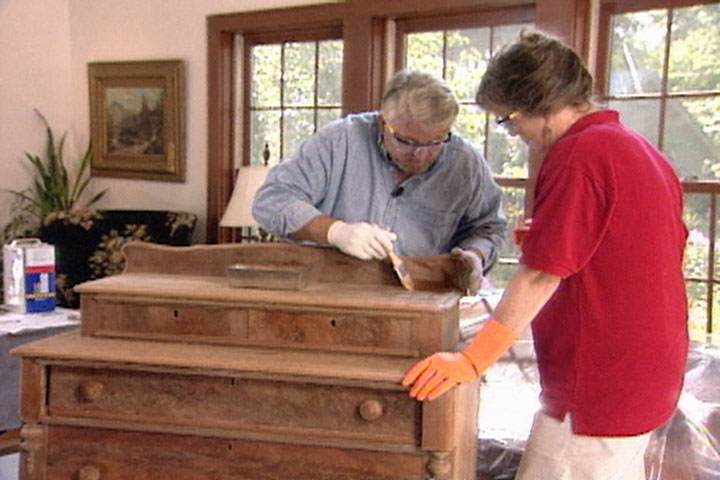3 Furniture Stripping Tips and Design2Share's DIY Rules
 September 29, 2011
September 29, 2011  Irwin Weiner ASID - If you're Ron Hazelton, home handyman and DIY expert, purchasing and restoring an antique dresser from a flea market is an easy-peasy snap. But you or I may have a few problems with project details. After all, in the do-it-yourself world, it's important to learn shortcuts and best practices. I found one of Ron's great, short-and-sweet tips videos on how to get stripper out of small details and recessed areas. He demonstrates three different ways to remove stripper "gunk" from hard-to-reach places, and I must say ... he makes me want to go out and find an antique door this weekend so I can try out one of his techniques. And one of them really does involve kitty litter!
Irwin Weiner ASID - If you're Ron Hazelton, home handyman and DIY expert, purchasing and restoring an antique dresser from a flea market is an easy-peasy snap. But you or I may have a few problems with project details. After all, in the do-it-yourself world, it's important to learn shortcuts and best practices. I found one of Ron's great, short-and-sweet tips videos on how to get stripper out of small details and recessed areas. He demonstrates three different ways to remove stripper "gunk" from hard-to-reach places, and I must say ... he makes me want to go out and find an antique door this weekend so I can try out one of his techniques. And one of them really does involve kitty litter!

The DIY rules here at Design2Share are simple: If you can have fun and enjoy a home remodeling or redecorating project - or in this case, furniture refinishing and restoration - and you can do it within a weekend or a short series of weekends or weekdays, then KNOCK YOURSELF OUT and tackle that do-it-yourself project. We wouldn't dream of stopping you. But if you won't enjoy the process, if there's a remote possibility that the project will drive you and yours nuts, and if the task at hand is too complex, then it's not a do-it-yourself assignment. Let's say you're changing out the plumbing in a This-Old-House bathroom and installing new pipes, wall boards, subflooring, tiles, and plumbing fittings and fixtures. This is far too complex and it will be a major disruption to your family life, so you're better off to hire professionals. That's what we're here for. In home remodeling, in particular, my clients often underestimate the amount of debris and floating dust particles in their home caused by even minor renovation work, so it's vital to have pros make the mess, keep the job site as clean as possible (hopefully while you've moved out or are isolated to a healthier part of your home), and finish up ASAP. Sometimes it takes a dedicated crew with years of experience under their belts to help you out - or you need to hire a great interior designer to keep your projects flowing smoothly and according to a master design vision that you've signed off on (subliminal message: "Call me and we'll talk!").
But I digress. Here's the video with Ron Hazelton's three tips for removing furniture stripper (available at any hardware store), from recesses and detail work.
 Ron Hazelton,
Ron Hazelton,  carpentry,
carpentry,  renovation,
renovation,  tips,
tips,  video in
video in  DIY,
DIY,  Do It Yourself,
Do It Yourself,  Irwin Weiner,
Irwin Weiner,  furniture
furniture 













Reader Comments (3)
Some really good tips here, especially the kitty litter used to get rid of the paint stripper. I ‘d have never have thought of this in a million years. I’ve been advised to patch up my doors to up my house valuation. Apparently it only takes a few simple steps like these to increase how much your home’s valued for.
Repair is a very important aspect of carpentry, woodworking, wood repair and wooden furniture care, due to the fact that furniture made out of wood has to be maintained, so that it looks attractive and be eye-catching. Stripping, or removing the old finish, is usually the messiest part of furniture restoration.
Refinishing offers the benefit of restoring your furniture, or the opportunity to give an old piece a trendy new look, or an enhanced new colour. Refinishing wood furniture restores the natural beauty of the wood, extending the life of the furniture and saving the homeowner the expense of buying new.